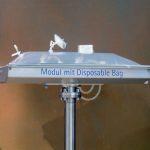Vital parameters for the product yield, such as agitation and heat transfer, have not yet been controlled to a satisfying extent in solid substrate fermentations. The special reactor design of the Continuous Flow Inversina combines the proven motion of the Inversina inversion mixers with an efficient aeration system for temperature control to create a complete system for solid substrate fermentations.
It is mainly fungi that are subjected to solid substrate fermentations because their filamentous structure facilitates growth on these substrates, but bacteria and yeast can also be cultivated in this manner. The advantages of this fermentation type are the relatively low costs and higher yields compared to equivalent submerged cultures.
During fermentations on solid substrates the water content in the reactor is low. This leads to a selective advantage of the fermented micro-organism over organisms which require submerged culture conditions, thus reducing the contamination risk and the costs compared to sterile processes.
The selective growth conditions of the respective micro-organisms and the low water content also facilitate higher product yields. The enzymes secreted are naturally more concentrated than in submerged culture. In most cases only small amounts of liquid are required for product recovery. The resulting high product concentrations simplify downstream processing, reduce the quantity of waste water and cut the costs.
Problems with the reactor design
Despite all these obvious advantages, solid substrate fermentation is not yet established as a high-tech process in many industrial branches, because the state of the art in reactor design lags behind fermenter engineering for submerged cultures. Owing to the complex conditions of solid substrate cultures, several problems with the reactor design need to be overcome.
During fermentation many different convection and diffusion processes occur between substrate particles as well as between the micro-organisms and the substrate. Oxygen and water or additional nutrients must penetrate all regions of the reactor as well as the micro-organisms. The product must be secreted in satisfactory concentrations and at the same time diffuse sufficiently from the micro-organisms to prevent product inhibition. These convection and diffusion processes largely depend on the humidity inside the vessel and the mixing of the reactor contents.
Substrates of all possible shapes and consistencies are used for solid substrate fermentations. They vary in particle size from powder (e. g. starch) to wood chips several centimetres in diameter. Mixing substrates of heterogeneous particle size is complicated and many fermentation processes therefore operate completely without agitation. This leads to heat gradients which intensify as the particle size decreases. Heat gradients are formed due to the metabolic heat of the micro-organisms during the fermentation and the relatively tight packing of the substrate that allows only poor heat transfer. Solid substrate reactors often make exclusive use of aeration to remove excessive heat. Substrates with a small particle size especially tend to form channels through which most of the air escapes. This leads to overheated and insufficiently aerated regions in the reactor. At the same time, carbon dioxide produced during the fermentation cannot be removed sufficiently. These effects cause changes in the metabolism and unfavourable fermentation results.
Even if relatively homogenous aeration can be ensured, e. g. by moderately filling the fermenter with a substrate of large particles, evaporation effects can occur due to excessive aeration. The consequences are substrate desiccation and suboptimal culture conditions resulting in reduced metabolic activity, slower growth of the micro-organism and finally reduced product yields. To counteract this effect, solid substrate fermentations are aerated with humidified air.
Excessive humidity can in turn negatively influence the oxygen transfer by reducing the substrate porosity, resulting in a changed metabolism and lower productivity. This fine balance of heat transfer, agitation and humidity must be considered in the reactor engineering and the design of the instrumentation and control equipment.
Reactor design for efficient mixing
Heat gradients, channel formation and inadequate aeration can be prevented by thorough mixing of the substrate. The agitation must be sufficiently intensive to ensure homogenous conditions for all types of substrate yet simultaneously gentle enough to leave the micro-organism intact.
Conventional agitation systems used in submerged cultures often fail to produce optimum mixing results. Product development engineers have a tendency to mistrust the packing glands and mechanical seals used in standard agitator drives. For these reasons agitation without a rotating seal and the transmission of rotary motion to closed containers in compliance with hygienic and safety requirements are a huge challenge for reactor builders. In submerged cultures magnetic stirrers are used as an alternative, but they are unsuitable for agitating solid substrates. Good mixing results have been achieved by moving the entire reactor. Bioengineering’s Continuous Flow Inversina for solid substrate fermentations uses the kinematics of inversion mixers as its mixing concept rather than rotation. Two PLC-controlled motors effect the inversion movement. This agitation strategy for solid substrate fermentations leads to gentle and controlled mixing of the vessel contents. At the same time, the reactor design allows the continuous supply and removal of air, additional substrates or buffers for pH control or product removal, because flexible lines or hoses can be connected to the movable reactor. The steam supply is mounted to the same connectors via sterile crosses, enabling steam sterilisation of the fermenter. Sterilisable inlet and exhaust air filters round off the plant for applications in the biotech, pharmaceutical and food industries.
Temperature and aeration control
One of the greatest disadvantages of solid substrate fermentations is temperature measurement and control, which is more difficult to effect than in submerged cultures. As mentioned above, the metabolic heat is removed most efficiently by the air supply. The cultivation temperature is often maintained in space-consuming climate chambers around the reactor. The Continuous Flow Inversina uses two different methods for temperature control.
The temperature of the exhaust air is measured by a temperature probe shortly after the air exits the vessel. A gas flow controller connected to this probe detects the exhaust air temperature and controls the inlet air valve according to the received signal and the parameters set in the controller. The fermentation temperature is thus controlled as a function of the inlet air dosage. Excessive metabolic heat is removed by high aeration rates, while heat gradients are prevented by the vessel motion.
The second temperature control method of the Continuous Flow Inversina entails a temperature controller, which controls the temperature of the water bath for air humidification. If the fermenter needs cooling, the inlet air flows through a cooled water bath. If the fermenter must be heated, it is aerated with warm air.
This twofold system has three major advantages over conventional temperature control: 1. Without a climate chamber it is space-saving and easy to handle. 2. If one of the two systems is insufficient in critical phases of the fermentation, the second temperature control can be added. 3. The two systems can be connected in a cascade. This means that the plant operator can precisely define the fermentation phases during which temperature or gas flow control is active and when both controllers should control the temperature simultaneously.
At the start of the fermentation the micro-organism must adhere to the substrate. The metabolic heat is not very high and the fermenter must be heated. If the micro-organism is in the exponential growth phase, the metabolic heat is high and the fermenter must be cooled. To ensure a sufficient oxygen supply during all cultivation stages, the aeration rate is set to a basic level in the cascade function. Depending on the requirements of the micro-organism and the nature of the substrate, the proportion of gas flow and temperature control is defined in the cascade. This allows optimum temperature control as well as an optimum gas supply and humidity during the entire fermentation.
Holistic system for solid substrate fermentations
With its cascade connection, the novel concept of aeration and temperature control of the Continuous Flow Inversina allows individual tuning of the fine balance between heat transfer and humidity for every substrate type and every cultivated organism. Inversion mixing facilitates the stabilisation of fermentation parameters and guarantees gentle operation. Together with standard components for sterile operation, such as sterile filters, steam sterilisation, sterile inoculation, etc., it creates a holistic system for solid substrate fermentation that complies with the regulations of the biotech and pharmaceutical industries. The Continuous Flow Inversina can also be equipped with disposable plastic containers for single-use fermentations.
cpp 468
Order documentation
Solid-State Fermentation Bioreactors: Fundamentals of Design and Operation (Hardcover)
Share:








